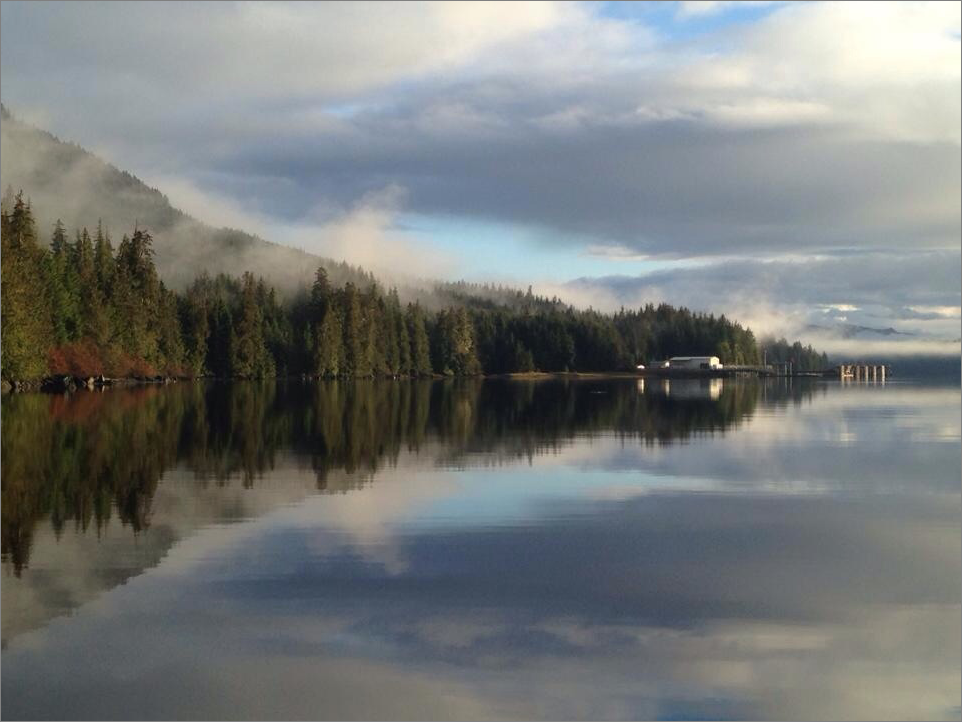“What Happened in Craig” After the dock walk with Charlie Clark, the troopers went their separate ways. Lieutenant McCoy traipsed down to the old cannery dock, looking for the Investor’s power skiff. His brief sweep of the skiff revealed nothing new, nothing interesting and nothing useful. McCoy’s next stop was in Hollis, on the other side of Prince of Wales Island. He had learned of another witness who had seen the skiff operator. This witness had been at the cold storage dock on the day of the fire and had seen the skiffman up close.
Excerpt from the unpublished original manuscript, “Sailor Take Warning,” by Leland E. Hale

Hollis Ferry Terminal, Prince of Wales Island (Annette Sharpe, Hollis, AK)
Paul Page told McCoy that he had pulled into a parking lot near the Phillips Cold Storage facility when some employees — which troopers knew to be Charlie Clark and a truck driver — “came running out with fire extinguishers yelling about a boat being on fire.” Page accompanied them down the dock to help load the fire extinguishers onto their skiff. “I could see the boat burning across the bay from where we were,” Page added.
As “Fat Charlie” and the volunteer raced off toward the burning boat, though, their small boat was swamped by the wake of the incoming seine skiff speeding directly toward the dock where Page stood. “About five feet from the dock, [the skiffman] put it into reverse to slow the skiff down,” Page declared. That landing smacked of an expert manuever by an experienced skiffman.

Finger docks, Phillips Cold Storage, Craig, Alaska (courtesy Alaska State Troopers)
Paul Page described a skiffman remarkably like the one seen by other eyewitnesses. And he added a few details the others had missed. He said the suspect was wearing a plaid shirt. He said his blondish hair was “kind of curly.” The suspect’s glasses, according to Page, were “wire framed.” And he was carrying a box under his arm, a light-colored box that resembled a large shoe or boot box.
The witness told the trooper that he tried to ask the man a couple of questions, but the man, “didn’t look directly at me, mostly at the ground and shuffled quite a bit.” He “kept repeating that he was in a hurry.” Page did ask if he was from the boat that was burning, “and he said no.” And then the skiffman asked Page if anyone had called the Coast Guard. Page told him he didn’t know.
Asked about the skiffman’s demeanor, Page replied that he was, “a little bit excited, but not too excited. I pointed at the fire and I asked him if he knew anything about it. He said, ‘No, no, not my boat, I don’t know nothing.’ And took off up the dock.”
Paul Page said he didn’t think the skiffman was wearing a hat, but said he had long hair, “over his ears.” He thought the skiff operator was clean shaven. Page also supplied McCoy with his next lead. He told the trooper that his girlfriend, Sue Domenowske, had spoken to the skiffman.
McCoy headed straight to Domenowske’s house, but there was one thing he hadn’t counted on. Sue’s house was on a beach road — and at high tide her road was covered with water. His interview of Sue Domenowske would have to wait for another day.
Copyright Leland E. Hale (2018). All rights reserved.

Order “What Happened In Craig,” HERE and HERE. True crime from Epicenter Press about Alaska’s Worst Unsolved Mass Murder.